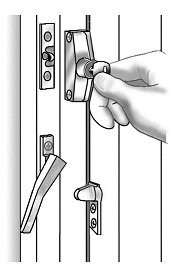Feedback on this page
Casement windows of all materials have a combination of one or more side or top hung opening frames set within an outer fixed frame. Each of these opening frames should be fitted with at least one casement window lock of the types described below. If you live in a high crime area or the opening casement is very large (1 metre +) you should fit two locks opposite each hinge. If the window has a scissor type hinge fit the locks to the opening/leading edge of the window.
Aluminium and steel windows can be locked in the same manner and there are locks specifically designed for use on metal windows. When drilling the pilot holes for the self-taping fixing screws be careful not to pierce the double glazed unit or allow the drill to slip onto the glass. Placing a few layers of clear sticky tape over the drill mark can help avoid drill slip. Steel windows of the type that use a cockspur handle can be fitted with a lock that prevents the handle from moving.
What is a secure window?
See Windows that should be locked for a definition
uPVC windows
uPVC windows that are not already fitted with multi-point locks (operated by the handle) should be fitted with specialist locks (see below). The fixing screws should be fitted through into the internal steel strengthening if the windows have them. It may be advisable to contact the manufacturer of these windows before attempting to fit locks, especially if the windows are still under warranty.
You are advised to use a Master Locksmith if you are not confident about fitting window locks, especially to uPVC windows.
New innovative uPVC security devices
A security company based in Portsmouth, Interlock Security, has recently developed and patented a number of security devices that are fitted alongside the locking systems already installed by the uPVC window manufacturer. With the development of these security devices and the correct application of security film on top of the glazing, householders can now improve the security of their existing uPVC windows and avoid the cost of total replacement. Please visit Interlock Security’s Directory page for more information.
Common casement window locks
 Automatic locks
Automatic locks
Automatic locks do exactly what they say; they lock automatically. You only need the key to unlock them so they are very useful if you want to leave the house or flat in a hurry. Simply close the window and it’s locked.
Press button locks
To lock the window you simply press the button. To unlock the window you need to use the key, but only if the button has been pressed in.
Swing locks
This type of lock is locked and unlocked using a key. Because of the way it works it pulls the fixed and opening casements tightly together and therefore helps to draught proof the window.
Disability option
Operating a swing lock requires you to turn the key around and around in the keyway and therefore may not be suitable for those of you who suffer from a disability. You should instead use an automatic or press button lock, which normally only requires a quarter turn of the key. You can also use the services of a locksmith who can fit purpose made locks that are more easily used by people with disabilities.
Flush casement windows
Some older houses may have been fitted with large flush casement windows where the outer frame and opening frames are flush with each other preventing the use of the three locks mentioned above.
Flush casement window locks
Window mortice security bolt
This lock is sometimes referred to as a mortice rack bolt. These locks should normally be fitted in pairs opposite the hinges and can be fitted into the moving or fixed frame, whichever is the larger. As the name suggests, the locking bolt is mortised into the timber frame at right angles to the grain of the wood (to prevent splitting) and by turning the key around a few times the bolt goes into the opposite frame. They can operate horizontally or vertically, whichever is most convenient. Most use a common key, but for added security you can buy them with key differs.
Pivot lock
A pivot lock (sometimes referred to as a semaphore lock) operates in the same way as an old fashioned railway signal. The lock is fitted to the opening frame (unless the window opens inwards) and by turning a key or a catch (which is then key locked) a bolt drops out of the lock over the fixed frame.
Operating a window mortice security bolt requires you to turn the key around and around in the keyway and therefore may not be suitable for those of you who suffer from a disability. You should instead use a pivot lock, which normally only requires a quarter turn of the key. You can also use the services of a Master Locksmith who can fit purpose made locks that are more easily used by people with disabilities.



